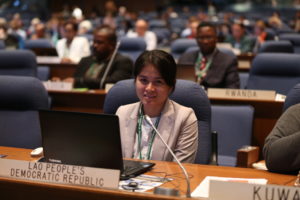Indonesia stresses need to combat invasive alien species
MONTREAL, Canada– Indonesia, supported by the ASEAN Member States, made a statement on the issue of the proliferation of invasive alien species (IAS) during the 22nd Meeting of the Subsidiary Body on Scientific, Technical, and Technological Advice (SBSTTA 22) of the Convention on Biological Diversity (CBD) on 4 July 2018.
Indonesia, represented by Dr. Gono Semiadi of the Indonesian Institute of Sciences (LIPI), stressed that the key to prevent spread of alien species is a strong border control. Weak control mechanism, lack of knowledge on various invasive species, their life cycles and their pathways for introduction, and unclear related law and regulation are among the problems that require common attention. Efforts to address these issues at national and regional level need to be supported.


While thanking the CBD Secretariat for all its guidance in abating the proliferation of IAS, Indonesia also wished to include on the mandate of the proposed expert group on IAS to address the issue of well-established invasive alien species spread in certain regional areas. The Golden Apple Snail (Ampullariidae) was mentioned as an example of a well-established invasive species in Southeast Asia. This species is also considered as the 40th worst alien species in Europe and is included in the Top 100 of the World’s Worst Invasive Alien Species. Indonesia furthered that other well-established species, particularly in Viet Nam, include mimosa trees, water hyacinth, and caterpillars. Lao PDR supported the ASEAN statement on IAS while seeking international assistance on the locust infestation in her country.
Majority of Parties to the Convention expressed the need for capacity building, technology transfer, and coordination and exchange of information among institutions on this biodiversity issue.
Keeping “intruders” out from the ASEAN region
In the ASEAN, the damage caused by IAS, as well as the programs designed to eradicate them, translates to significant economic and monetary losses. According to a study (Nghiem et al., 2013), that used cost-benefit analysis and other models, the total annual loss equivalent to the economic and environmental impacts of harmful nonindigenous species in the region was estimated at USD 33.5 billion. This was further broken down into losses and costs to the agricultural sector (USD 23.4–33.9 billion), human health (USD 1.4–2.5 billion), and the environment (USD 0.9–3.3 billion).
“Invasive Alien Species are threats to the balance of natural ecosystems. Their presence poses risk as unwanted predators of endemic species. Many of the introduced species have become pests; disturbing ecosystems, and affecting livelihoods of many resource-based income earners depending on ecosystem services such as on agriculture. Case in point is the golden apple snail which is an introduced species in Lao PDR and the Philippines. These IAS are now menacing rice production in these areas,” said Dr. Theresa Mundita S. Lim, SBSTTA Chair and ASEAN Centre for Biodiversity (ACB) Executive Director.
Invasive alien species have common characteristics: they can thrive under adverse conditions, reproduce and grow rapidly, have high dispersal ability and adaptability to new conditions, and survive on various food types and in a wide range of environmental conditions. As these invasive species prevail in their new environment, indigenous species are unable to compete for space and food or are prey for the IAS, and eventually become extinct. Vital ecosystem functions, such as pollination, soil regeneration, and nutrient and water cycling functions, among others, eventually deteriorate. For example, a common myna can drive away native birds by occupying their nesting areas. Mimosa pigra, a thorny shrub with buoyant seeds that grow abundantly in mudflats, can drive away migratory birds feeding and nesting in these areas.
The ACB supports the ASEAN Member States in undertaking measures to cope with and come up with control measures on IAS through capacity building on taxonomy, information sharing through the ASEAN Clearing House Mechanism, and awareness raising. Cambodia, Indonesia and the Philippines crafted their National Invasive Species Strategy and Action Plan (NISSAP). Thailand has established a list of IAS and developed national IAS control measures. In Viet Nam, a strong legal regulation system on import and export of biological materials is in place. All AMS are managing and controlling priority IAS, either manually or through the use of appropriate chemicals. The Integrated Pest Management (IPM) approach is also being applied particularly for IAS affecting the agriculture sector.
In-depth research, survey, and analysis of priority IAS in the ASEAN region, including its pathways of introduction were also identified as measures to further understand IAS and draft measures for its control and eradication.
The ACB was established in 2005 by the ASEAN Member States as a response to biodiversity loss in the region. The Centre supports and coordinates the implementation of activities in the ASEAN leading to the conservation and sustainable use of biological diversity, for the benefit of the region and the AMS.
